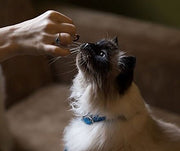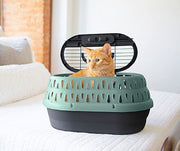Different Types of Cat Litter - Which is Best?

As a pet parent to an adorable little kitty, you already know the importance of cat litter. For some cat owners, the process is relatively simple. They buy a litter box and a popular brand of kitty litter, and aside from the potty training, everything seems to fall into place.
For others, there's some trial and error involved. You might begin to notice some interesting odors around your cat's litter box, or perhaps your cat may be avoiding them altogether. This might be a sign that it's time to try out a different type of cat litter.
While we definitely celebrate having different choices, with so many options to choose from, knowing which type of litter to try out next can be a confusing and overwhelming process. To give you a hand, we've put together this helpful guide covering different types of cat litter and tips for transitioning to a new one.
1. Non-Clumping Cat Litter
Non-clumping cat litter is the grandfather of commercial cat litter. As the name indicates, this type of cat litter doesn't clump when your cat uses it. Your cat's dropping stays where they are left rather than forming easier chunks to scoop out. Despite its inability to clump, this variety of litter still absorbs moisture, which helps to remove odors.
As the litter becomes more saturated, urine may begin to accumulate at the bottom, making it difficult to clean soiled chunks without emptying and cleaning the entire litter box. For some, this may be an incentive to use a non-clumping variety. For those who are used to periodically cleaning out smaller chunks, it may be more of an inconvenience.
Non-clumping cat litter is often made of wood, pine, walnut shells, recycled paper, and silica.
Pros of Non-Clumping Cat Litter:
- Less expensive than clumping varieties
- More choice of materials
- Less dust
- Less daily maintenance
Cons of Non-Clumping Cat Litter:
- Doesn't clump
- Shorter shelf life (and litter box life)
- Entire tray needs to be cleaned more often (once a day)
- Cat waste can be harder to locate
2. Clumping Cat Litter

Clumping cat litter is the most common commercial cat litter available on the market today and the most popular choice. Most varieties contain bentonite that facilitates clumping as the litter absorbs liquid. Clumping cat litter is often made of materials such as clay, corn, coconut husk, and wheat.
Since urine doesn't pool at the bottom of the litter box, the urine and feces can be quickly scooped out without having to change out the entire box. Cleaning litter can be added to their place as the soiled chunks are removed. However, this doesn't mean you won't ever need to empty your litter box. Rather, the litter box must be emptied once a week instead of daily with non-clumping varieties. Clumping clay litter is particularly beneficial for multi-cat households due to its easy cleaning and effective odor control.
If you're shopping for a kitten, we recommend staying away from clumping varieties to avoid the risk of ingestion. Kittens may try to eat their feces out of curiosity, and ingesting litter may lead to an intestinal blockage.
Clumping cat litter is often made of clay, corn, coconut husk, and wheat.
Pros of Clumping Cat Litter:
- The litter clumps after your cat has used the restroom
- Better at absorbing odors
- Easier to clean
- Easier to find cat waste
Cons of Clumping Cat Litter:
- Can be more expensive
- Fewer choices of materials
- More dust and tracking
- Not suitable for kittens
3. Unscented or "Odorless" Cat Litter
Unscented cat litter is made without additional scent agents. Many varieties still contain odor-neutralizing agents such as carbon, baking soda, or even fragrances designed to smell like nothing, so you'll see many unscented types branded as "odorless."
Pros of Unscented Cat Litter:
- Traps urine and odors
- Odor neutralizers can mask the ammonia smell
- Ideal for cats and owners who are sensitive to smells
Cons of Unscented Cat Litter:
- "Odorless" quality may contribute to a "cat box smell."
- It can require more frequent cleaning, depending on your tolerance for odors
4. Scented Cat Litter
Scented cat litters have additional scent agent ingredients to emit a more pleasant, intentional smell. Most scents already come mixed with the cat litter, but some varieties offer separate deodorizes to be added later.
Humans may be more receptive to scented varieties of cat litter, but are cats? Scented options may give off a slight whiff of a smell like lavender to us, but cats have a much more developed sense of smell than humans do. What seems like a light spritz of fragrance to us could be an overpowering inconvenience for your cat.
Additionally, while many pet parents are drawn to scented litter for odor control, it's important to consider the potential allergic reactions or aversion in cats due to the strong chemical scents.
Pros of Scented Cat Litter:
- Odor-blocking scents
- Keeps litter box fresher between changes
- Can make the litter box easier to hide in the home
Cons of Scented Cat Litter:
- Can be too overpowering for some cats and humans
- Your cat may smell like the litter
Recommendations Based on Cat Needs
Choosing the right litter often depends on specific needs:
- Multi-cat households might benefit from strong multi-cat formulas. It is also recommended that multiple litter boxes be placed to provide adequate space and prevent stress.
- Long-haired breeds could do better with a low-tracking, larger grain litter.
- Kittens require non-clumping litter as they may ingest it during grooming.
- Elderly cats benefit from softer litters, such as recycled paper, due to their gentle texture. Paper litter is also suitable for cats with allergies or post-surgery care.
- Corn cat litter is an environmentally-friendly option that is flushable and clumps decently, but it may not have the best odor control and can be prone to tracking. Additionally, cats with food sensitivities to corn may not do well with this type of litter.
Petmate's Top Entry Litter Pan & Accessories Value Pack

For a cleaner and more contained litter solution, consider the Petmate Top Entry Litter Pan & Accessories Value Pack. This kit is ideal for homes with dogs or small children, keeping the litter in and the curious out. Its high walls and textured lid trap litter from your cat’s paws as they exit, reducing spillage and scattering on your floor. The included liners simplify cleaning by allowing all the contents to be lifted out without scooping, while the custom-designed scoop aids in regular maintenance.
Cat Litter Choices: Simplifying Your Decision
Finding the right cat litter can significantly improve your living environment and your cat’s happiness and health. By considering factors like odor control, maintenance level, and your cat’s preferences, you can choose a litter that works best for you and your pet.
For those looking to enhance their cat care arsenal with premium products, Petmate offers innovative solutions that cater to pet parents and furry friends' needs. Visit us today to explore how Petmate can help you maintain a clean and welcoming home for your cat.
Choose wisely, and you’ll find that the best cat litter is the one that meets the unique needs of your household and the preferences of your cat, making your life easier and your cat’s more comfortable.
Previous article

Next article

Related posts
View all-

Can My Dog Learn to Use the Cat Litter Box?
Some owners wonder: can dogs learn to use a cat litter box? It’s a practical solution for small, older, and even puppies. If cats can do it, why not our canine companions? The idea sounds simple enough, but it’s not as straightforward as tossing down a litter pan and expecting results. Dogs have different instincts, and training methods vary. Without the correct litter box, consistent training, and proper rewards, it may seem impossible.
Read Article -

How Do You Make a Bed for a Cat
Making a bed for your cat is a fun, creative, and cost-effective project. Cats love to curl up in soft, cozy spaces, and creating a custom bed ensures your furry friend has the perfect place to rest. Whether you’re using an old sweater, cardboard boxes, or spare fabric, a homemade cat bed can be just as comfy as store-bought cat furniture. You can make a bed matching your kitty’s personality and home décor with basic sewing skills and simple materials.
Read Article -

How Do I Get My Dog to Share Her Toys with the New Puppy
Bringing home a new puppy is exciting, but it can also bring unexpected challenges to your household. One of the most common struggles dog owners face is getting their older dog to share toys or space with the new pup. While it’s normal for dogs to feel possessive of their belongings, this behavior can escalate if not addressed.
Read Article



